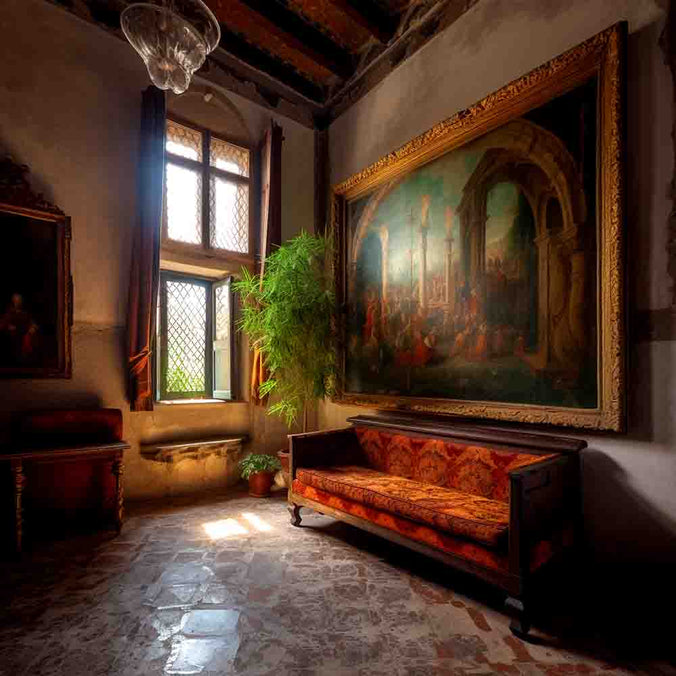The Unique Qualities of Oil Painting: A Timeless Art Form

The Unique Qualities of Oil Painting: A Timeless Art Form
Oil painting is a versatile and enduring art form that has captivated artists and art enthusiasts for centuries. With its rich colors, flexibility, and ability to preserve fine details, oil painting has a unique appeal that sets it apart from other mediums. At My Photo Art, we appreciate the timeless beauty of oil paintings and are committed to providing our customers with high-quality art that enriches their living spaces. In this article, we'll delve into what makes oil painting so special and how it can enhance your home.
The Richness of Oil Paint Colors
One of the most appealing qualities of oil paints is their remarkable color intensity. Oil paints have a higher pigment concentration than other types of paint, resulting in vibrant, long-lasting hues. This makes them an excellent choice for artists who want to create captivating and enduring works of art. Moreover, oil paints maintain their color vibrancy even after drying, unlike acrylics, which tend to darken.
The Flexibility of Oil Paints
The slow drying time of oil paints allows artists to work with the medium for extended periods, blending colors and creating smooth transitions between shades. This flexibility also enables artists to paint over areas and build up layers, resulting in complex compositions and textures. Oil paintings can be large and are more resistant to cracking than tempera or encaustic artworks, making them a popular choice for many artists.
Impasto and Fine Detail Techniques
Oil painting allows artists to apply paint in various ways, from thick impasto to intricate details. Impasto, a technique where paint is applied thickly to create texture, has been used by many modern abstract expressionists and colorists to achieve unique effects. On the other hand, the slow drying time of oil paints also enables artists to create fine details and delicate brushstrokes for more realistic representations.
Affordability of Oil Paintings
While oil painting can be an expensive hobby, there are affordable options for those looking to own or create beautiful oil paintings. Buying canvas rolls in bulk, stretching them yourself, or purchasing inexpensive supplies can help keep costs down. Moreover, websites offering affordable oil paintings and reproductions provide an accessible way to acquire artwork that suits your taste and budget.
The Protective Role of Varnish
To ensure the longevity of oil paintings, they are often varnished. Varnish protects the artwork from dirt, contaminants, and UV light, preserving the colors and quality of the piece. Applied in layers, varnish also provides a glossy finish, enhancing the visual appeal of the painting. In addition to protecting the artwork, varnishes make oil paintings water-resistant, ensuring that they will remain in excellent condition for generations to come.
The History of Oil Painting: Origins and Influential Artists
The oil painting has a rich history that dates back to the 7th century when artists in Afghanistan used oil-based pigments for Buddhist paintings. However, it wasn't until the 15th century that oil painting became popular in Europe, with the Flemish painter Jan van Eyck being one of the pioneers. The Renaissance saw the emergence of many influential artists who utilized oil paints, such as Leonardo da Vinci, Michelangelo, and Titian. As the medium evolved, it became the preferred choice for artists like Rembrandt, Vermeer, and Caravaggio, who capitalized on the unique properties of oil paints to create realistic, expressive, and detailed artworks. Throughout the centuries, oil painting continued to be a dominant medium, inspiring artists like Monet, Van Gogh, and Picasso to create their masterpieces.
Popular Oil Painting Techniques: Alla Prima, Glazing, and More
There are various oil painting techniques that artists employ to create different effects and styles. One popular technique is alla prima, or wet-on-wet painting, where artists apply layers of wet paint onto the canvas without waiting for the previous layer to dry. This allows for spontaneous, expressive brushstrokes and blending of colors directly on the canvas, as seen in the works of Vincent van Gogh and John Singer Sargent.
Another technique is glazing, where thin, transparent layers of oil paint are applied over an opaque underpainting. The glazes create depth and luminosity in the artwork, as the light passes through the transparent layers and reflects off the underlying colors. Glazing was extensively used by Old Masters like Rembrandt and Titian to achieve their rich, glowing effects.
Other techniques include scumbling, dry brushing, and impasto. Scumbling involves applying a thin layer of paint over a dry underlayer, allowing the lower layer to partially show through. Dry brushing is the application of paint with minimal or no solvent, creating a rough, textured effect. Impasto, as mentioned earlier, is the use of thick layers of paint that retain brush or knife marks, adding depth and texture to the painting.
The Role of Oil Painting in Contemporary Art
Although there have been significant advancements in various art mediums, oil painting continues to hold its place in contemporary art. Artists like Gerhard Richter, Jenny Saville, and Cecily Brown have embraced the versatility and richness of oil paints to create distinctive, thought-provoking works. Contemporary oil painters often experiment with new materials, techniques, and styles, pushing the boundaries of the medium while remaining rooted in its history and tradition. Oil painting serves as an essential tool for contemporary artists to express their vision and engage with a diverse audience.
Famous Oil Paintings and Their Stories
Throughout history, oil paintings have left an indelible mark on art and culture.
Some of the most famous oil paintings include:
- The Mona Lisa (1503-1506) by Leonardo da Vinci - Known for her enigmatic smile, the Mona Lisa is arguably the most famous artwork in the world. The painting showcases da Vinci's mastery of the sfumato technique, where subtle gradations of color are used to create a soft, atmospheric effect.
- The Starry Night (1889) by Vincent van Gogh - This iconic painting captures the beauty of the night sky with swirling, expressive brushstrokes and a unique color palette. Van Gogh's use of impasto and vibrant colors create a sense of movement and energy that has captivated viewers for generations.
- The Persistence of Memory (1931) by Salvador Dalí - A prime example of Surrealism, this painting features melting watches draped over a desolate landscape. The work symbolizes the fluidity and instability of time, highlighting the surreal and dreamlike nature of our perception of reality. Dalí's unique approach to oil painting and his ability to create striking imagery has made this painting one of the most recognizable and influential pieces of modern art.
- Girl with a Pearl Earring (1665) by Johannes Vermeer - Often referred to as the "Dutch Mona Lisa," this captivating portrait showcases Vermeer's remarkable skill in rendering light and texture. The contrast between the dark background and the luminous face of the subject, as well as the delicate details of her clothing and jewelry, demonstrate the potential of oil paints in creating lifelike and evocative images.
These iconic oil paintings, among countless others, have shaped the course of art history and continue to inspire contemporary artists and art enthusiasts alike. The unique qualities of oil painting as a medium have contributed to the creation of some of the world's most cherished and celebrated artworks.
Oil painting is an exceptional and enduring art form that has captivated artists and art enthusiasts for centuries. Its unique qualities, such as the richness of color, flexibility, capacity for impasto and fine detail, and the slow drying process, have made it a favored medium for many of history's most celebrated painters. This article has explored the advantages of oil painting, delved into its storied history, and highlighted some of the most iconic oil paintings that have shaped the course of art history.
From the vibrant color possibilities and flexibility in technique to the long-lasting nature of oil paints, it is clear why this medium has remained popular and influential throughout the years. Additionally, with the inclusion of famous works such as the Mona Lisa, Starry Night, The Persistence of Memory, and Girl with a Pearl Earring, we can better understand the impact that oil painting has had on the world of art. As you explore the fascinating world of oil painting, whether as an aspiring artist or an art lover, this deeper understanding of its unique qualities will undoubtedly enhance your appreciation for this powerful and timeless form of artistic expression.
Leave A Reply
Your email address will not be published. Required fields are marked *






